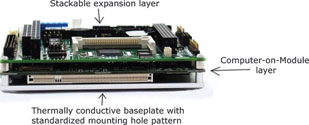

Much has changed since PC/104 spawned the stackable single board computer (SBC) market back in the early 1990s.
On the functional and silicon level, nearly every facet of embedded computing technology has advanced in accordance with Moore’s Law, doubling in density or performance every two years. In the embedded PC realm, x86 CPUs have progressed from 32-bit sub-100 MHz 386s to 64-bit multicore multiGHz chips such as Intel’s Core 2 Duo.
A full PC system’s worth of functionality now resides within one or two surface-mount chips. Bulky, parallel system buses and I/O interfaces are dissolving into a handful of high-speed serial signals. Terabyte hard drives fit in the palm of a hand, and multigigabyte Flash modules are the size of a coin. The functions of an IBM PC have been crammed into ever-smaller ‘stackable SBCs’. Despite this rapid evolution in embedded CPU, bus and interface technologies, advancements to embedded board- and module-level architectures have lagged.
In recognition of this situation, the embedded hardware ecosystem has begun scrambling to define board and module standards that can accommodate new technologies such as Intel’s Atom and Core 2 Duo ULV processors, PCI Express, SATA, USB 3 and HD A/V. This impending transition is starting to shatter the mould of the past two decades, as various new (and largely untested) embedded board and module standards have started to emerge. This article investigates one such evolutionary advancement – ‘Embedded-Ready Subsystems’ – a solution developed by Diamond Systems which provides a high-level embedded system design paradigm.
Stacking up solutions
In the traditional stackable-SBC architecture, an off-the-shelf SBC – which could be EBX, EPIC or PC/104 sized, among other form-factors – serves as the heart of the embedded system, and one or more standard or custom PC/104-style expansion modules are added to tailor the system to a particular application. While this works fine in many cases, the stackable-SBC approach cannot satisfy the size, weight, power, thermal and complexity restrictions of many OEM applications. In addition, stackable systems generally are not cost-effective for large volume applications.
Consequently, SBC vendors have been forced to develop custom, application-specific SBCs for many of their customers. Because this process bears the burden of high development costs, time-to-market uncertainties and component obsolescence nightmares, it is only appropriate for high-volume applications that will require several thousand boards or more.
The COM compromise
In an attempt to alleviate the need for full-custom designs, another board-level computing approach arose: the combination of standardised ‘computer-on-modules’ (COMs) – which encapsulate CPU and generic system I/O functions – with custom COM baseboards that integrate real-world I/O and other application-specific functions.
The COM + baseboard approach offers several key advantages, including:
* Reduced development costs/risks/time – restricts custom design requirements to application-specific functions, thereby reducing development costs and risks, and shortening development cycles.
* Advanced core computing technology – immediate access to the latest CPU and system I/O technologies, without having to invest in reinventing the wheel.
* Performance flexibility – a single base design can be offered in a range of price/performance models, or can be upgraded in the future.
* Cost reduction – standards-based COMs have achieved high-volume commodity status, especially in contrast to most SBCs.
* Increased time-in-market – having the computing core on an interchangeable COM protects against component obsolescence and facilitates lifecycle extension.
Despite its many benefits, however, the COM + baseboard approach bears a substantial price tag: the time, cost, and risk of designing (and maintaining) the requisite custom application baseboard.
Introducing the ‘Embedded-Ready Subsystem’
Diamond’s Embedded-Ready Subsystem approach offers the best of both the SBC and COM worlds by building a bridge between the two, by integrating a selected COM standard (eg, COM Express) plus a selected modular expansion standard (eg, SUMIT-ISM), along with a reliable mounting and thermal management solution. Significantly, this approach does not require developing a custom baseboard.
In this manner, the Embedded-Ready Subsystem combines the benefits of COMs with the flexibility of modular, stackable expansion. Additionally, its large thermally-conductive base-plate serves to provide a standardised mounting-hole pattern, similar in concept to that defined for VESA displays. With this approach, choice of CPU form-factor (ETX, COM Express, PC/104, EPIC, EBX, etc,) and expansion bus type (PCI-104, SUMIT, PCI/104-Express, etc,) become less important than overall functionality requirements. Essentially, it is bus and CPU format agnostic, thus opening up the system architecture to a wide range of options.
Consequently, embedded system developers have a wide range of off-the-shelf options available, from which to assemble the target system’s embedded electronics. This enables enhanced focus on the application’s unique requirements – typically value-added real-world interfaces and operational software – and reduced distractions from generic embedded computing issues, such as keeping up with state-of-the-art CPUs, chipsets, memories, interfaces, buses and relevant BIOS technologies.
Beating custom at its own game
In applications where cost, space or power consumption constraints demand a more optimised solution than what is available with off-the-shelf components, the Embedded Ready-Subsystem’s stackable expansion layer plus one or more expansion modules can be replaced by a custom application layer, which integrates the application’s unique functions and interfaces. This architecture would still retain the use of COM modules because of the overwhelming advantages compared to a full custom all-in-one design. Despite being burdened by a costly development cycle, for annual volumes of several thousand units or more, this partially custom Embedded-Ready Subsystem approach provides some advantages over traditional full-custom SBC designs, including a compact shape with standardised mounting holes; efficient thermal solution; and easy upgrades for increased performance or avoiding CPU obsolescence.
| Tel: | +27 12 493 0852 |
| Email: | [email protected] |
| www: | www.epd.co.za |
| Articles: | More information and articles about Electronic Products Design |

© Technews Publishing (Pty) Ltd | All Rights Reserved